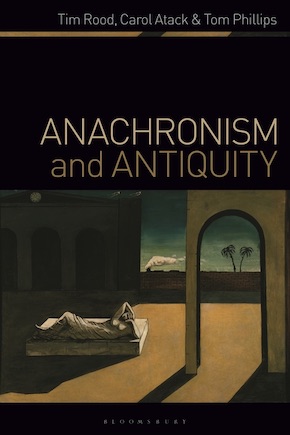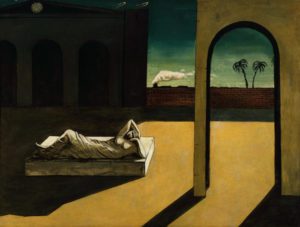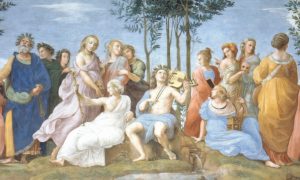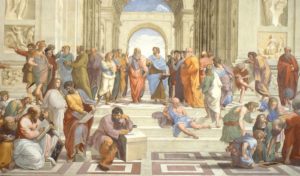It’s about time
by Mika Provata-Carlone
“Ranging from Homer to Borges, this book shows how anachronism is inseparable from our understanding and appreciation of past and present.” John Marincola, Florida State University
Periods of calmness and peace are often likened to infinity; when the passage of time is blissfully suspended, or sublimely extended beyond the limits of human reckoning or reason. Times of crisis, on the other hand, such as war, are characterised by the particular effect they have on the very notion and substance of time. War does not simply ravage lives and the materiality of civilisations; it especially devastates time itself: human time, historical duration, temporality, as well as eternity. In the atemporal no man’s land of war, remembrance of the past, or any vision of the future, are rife with danger: they interpose a ‘normal’ existence and analysis at the very heart of where ‘normal’ cannot exist – where ‘normal’, moreover, drastically destabilises the explicit process of dehumanisation on which war as a prospect and as a praxis depends. Time and war are mutually contradictory. Either of the two must be suspended if the other is to subsist. One writer who was singularly sensible to the critical relationship between existence and time, between human life and temporality, was Homer. Both his Iliad and his Odyssey are a fundamental engagement with the dialectics of reality and illusion, unswervingly anchored on a variant of our perception of time, and on an essentially chronistic definition of our being: the two epics are transfused with states of diachrony, synchrony, allochrony, anachrony, asynchrony or dysynchrony; they are about being in time, or exiled from time.
In the Iliad, Andromache and Hector cannot articulate either past or future when they meet for the very last time; they know time is a hostage to war. Achilles can only remember the time away from Troy with mēnis, and he self-negates futurity with the fatal choice he knows he cannot but make. His argument with Agamemnon is, if anything, about the timeliness or dysynchrony of a human and divine ethics: Agamemnon upholds the suspension of such ‘normal’ ethics, claiming his ‘right of the sword’; Achilles responds allochronistically, as regards the context of the epic: he vainly attempts to introduce a different dimension of existential time, and the ethics of ‘normal’ social structures, thus causing a jarring malfunction to the time warp of war. The scene between Priam and Achilles, and the funeral of Hector which concludes the epic, are perhaps the most poignant sociohistorical analyses and the starkest anachronisms of the poem: they embody the bluntest awareness of the end of an era, of a radical historical transition, not only for Troy, but also for the age of heroes, to which both Priam and Achilles belong. They signal a processional (dynamic and progressive) perspective rather than a static perception of history and of time. The Iliad depends on this disturbance of the proprieties of time, on the suspension of the temporality of lives, on the stomping out, especially, of the sense of a passage of time, which would allow for the creation of a narrative of existence. It is a truly arresting poetic device that Homer uses here, and one that he inscribes in his most celebrated poetic image – the design on Achilles’ shield, where a single murder disrupts, and literally rips apart the fabric of time and eternity. In order to understand the Iliad, Homer’s audience needed to have a very strong, dialectical sense of the ebb and flow of time, its ineluctable movement from one state of humanity to another. It needed to possess the awareness of a critical distance (which Homer also achieves through the interpolation of material anachronisms in the course of the poem), and the conscious tools for an analysis of this thrust towards both identity and otherness, towards both continuity and rupture.
Homer is perhaps the first cogent paradigm of a theorised praxis of time, and he may even be said to be the starting point of a genealogy of thinking theoretically about historical belonging.”
Homer’s second epic, the Odyssey, is often described as a poem of nostos or of many nostoi, of returns to historicity from timelessness. The focus is primarily on Odysseus’ process of rehumanisation, but this rehumanisation is unambiguously represented as a pageant of history and civilisation, an elaborate survey of humanity’s progress from barbarity, or a mythic time, to an Elysian idyll now irretrievably lost, and finally to a vision of hard realism, but also of a desirable reality regained. Odysseus’ travels are extraordinary metaphors of allochrony and anachronism, evincing a startling awareness as regards both the depth and the synchrony of history. The parallel odyssey undertaken by Telemachus is sometimes overlooked as a minor theme, yet it is the essential bass clef tune to Odysseus’ treble, which carries the melody. Telemachus seeks news of his father – and his journey takes him through a highly dramatic sequence of private and more broadly cultural anachronisms, which bring to the foreground the critical role of time for individual or sociohistorical existence. As he visits the other Greek leaders who have returned from Troy, he must confront Agamemnon’s hubristic tragedy, his anachronistic violation of peace via the mentality of war, for which he paid with his life; also Nestor’s illusory anachronism of existing in a time that no longer is – and can no longer be; he must challenge Menelaus’ and Helen’s delusional de-anachronism of a double erasure (over Trojan time and Helen’s time in Egypt), their world of atemporality achieved through memory-lulling, time-blurring potions. Telemachus must recapture his father’s time, but also his own; he must acknowledge both linearity and cyclicity, multitemporality and diachrony, as well as the highly individual, personal experiencing of time which alone confirms being. Odysseus must re-enter time on Ithaca, reclaim time from the suitors, prove himself worthy of the diachronic presence of his home and the solid being-in-time of his wife. In their tensely synchronised parallel returns, father and son are exemplars of the way time was perceived and experienced, but also problematised in the ancient world, of the ancients’ understanding of the critical balance between being and non-being, timeliness and timelessness, between a personal narrative and a sense of historical becoming. The cyclicity of Odysseus’ peregrinations is interwoven with the linearity of Telemachus’ own journey (a pattern James Joyce would spot and emulate in Ulysses, in the metatemporal figures of Stephen Dedalus and Leopold Bloom), and the convergence of their two narratives (and Penelope’s own third) evinces the complex structures of perception and ideation that Homer musters in order to create both plot and meaning.
Homer is perhaps the first cogent paradigm of a theorised praxis of time, and he may even be said to be the starting point of a genealogy of thinking theoretically about historical belonging. He was certainly not the only one, and there may have been others before him, whose voices we can no longer hear. Time was of the essence, not only in ancient literary texts, but also in the writings of the philosophers, in the historical works we have from both Greek and Roman authors. In the echoes of everyday life that we have from Plato, Aristophanes or the tragedians, Cato or Seneca, Plutarch and Xenophon, Menander, Ovid and Lucan (and so many others, earlier and later, in full texts or in fragments), historicised and theorised time seems to be a subject of common conversation in the mouths of ordinary women and men, walking in the street or chatting at symposia and convivia. Herodotus’ sense of a duty to time, of a debt to the integrity of the past, reveals a particularly incisive understanding of the complexities of historiographical inquiry and history, the dynamic determinism of the latter over human life. Thucydides, Xenophon and Plutarch use time past, time present and time future in order to construct complex reflections on the meaning of individual agency, the role of social forces, the precarious balance between what has been and what may undergo change. Time for the Romans was above all political and national time, with a potential for retrospective resynchronisation of ends and beginnings, for the ratification or erasure of centres of cultural and political authority. When Virgil quashes together the timelines of Aeneas and Dido, he programmatically displaces and appropriates time; when he dedicates some of his most exultant lines to the lusus Troiae, the Trojan Games in honour of the dead Anchises, he is once again warping time, making a very specific statement about the ownership of history: the Aeneid symbolically references the foundation of Rome, the start of time-measuring for Romans; by incorporating the Games, which Augustus had also revived at the same time, Virgil seizes as his spoils of a cultural war the beginning of time-measuring for the Greeks, namely the Olympian Games, traditionally dated to 776 BC, which he now superimposes to the date normally given to the founding of Rome, 753/2 BC. Time was vital, as was a precise understanding of its recurrent exemplariness, its linearity, its proclivity to dealign itself from any safe formula or pattern. The ancients’ sense of identity depended crucially on time’s otherness and subjectivity, on an awareness of history as a narrative of critical meaning.
Greece and Rome were societies which combined in consciously informed and dialectical manner both modern and premodern understandings of history and time.”
Ancient time was also highly idiosyncratic and often quirky, as Denis Feeney has argued in Caesar’s Calendar, where he shows that it was also a bit of a headache. The key precept underpinning his study of ancient chronology is that Greece and Rome were societies which combined in consciously informed and dialectical manner both modern and premodern understandings of history and time. They were “distinctively responsive to any avenue of inquiry”, for all the issues involved in “cross-cultural comparisons”. He dismisses “the deep relativism of the Lévi-Straussian model, while still allowing plenty of room for specificity.” Feeney is keen to allow the ancients to exist free of the prejudices of the present, uncluttered and unbiased by our own anachronistic projections – including the practice of BCE and AD dating, where he follows Walter Burkert in order to make us conscious that our sense of continuity must respect a crucially dialectical alterity of the past: Rome was founded in 753/2 “BCE”, according to that scheme, since the date, by ancient standards, is clearly anachronistic.
Caesar’s Calendar made a strong case for the ancients’ multifaceted engagement with time, yet it also incited a new wave of partisan historical revisionism or postmodernism. “Recent historiographical thinking has often denied to the ancients an understanding of history as a domain of inquiry in its own right, separate from experience of the present,” wrote Tom Phillips in 2018, referencing Zachary Schiffman’s militant claims in The Birth of the Past (2011), that “the ancients were never able to elevate ‘differences between past and present… to a principle of historical knowledge.’” Schiffman, and authors adhering to what may be loosely described as a school, define the relationship between ancient Greeks and Romans and the past as being static, cyclical and undifferentiated, as being dependent on and delimited by the concept of universality, immutability and repetition, ignoring contingency or variability. It is a forceful ideological thrust that Phillips, together with Tim Rood and Carol Atack, spiritedly intend to counter and disprove in their own study, Anachronism and Antiquity, where they seek to show that the ancients’ sense of history is a much richer, deeply complex, and polyphonic discourse, erroneously juxtaposed to what is claimed to be the chronistic revolution of the Renaissance. Above all, they demonstrate that it is to the ancients, and to the very precepts of an evolving and dynamic pre-Renaissance mind, that we owe our own understanding of a ‘creative’ or ‘productive’ anachronism today, which enables us to experience that very ancient and timeless Aristotelian concept, the dialectics of a historical and conceptual, ineffably human, methexis.
Anachronism and Antiquity is a riveting, unapologetically intelligent read, and it is clear that Rood, Atack and Phillips believe that their subject is particularly urgent and vital. In exploring the multiple ramifications of our engagement with time, in what is a vast corpus of theoretical analyses, historiographical texts and philosophies, philological and literary exegeses, comparative art-historical investigations, or etymological discourses that expose startling ethnographic and sociocultural layers, they display a thrilling sense of clarity, polymathy and rather exciting erudition, the interdisciplinarity of any true intellectual enterprise, all of which they share with true scholarly humility. Their engagement with both past and present is unwaveringly dialectical, reflected and deferential, even when declaring strong and unmitigated disagreement or critical objection (Schiffman is an obvious antagonist). Unafraid to take on sacred monsters (Jean-Pierre Vernant, Paul Veyne, Pierre Vidal-Naquet, Claude Lévi-Strauss, Oliver Taplin, Bernard Knox…), and keen to acknowledge their debt to intellectual companions (Anthony Grafton, Denis Feeney, Armand d’Angour, Pat Easterling, perhaps Jonas Grethlein…), they are engrossingly close readers of a gorgeous array of texts, which they select from a singularly impressive, truly inclusive, broad spectrum of fields, and they evince a sprightly talent for capturing both forests and trees in their own vision of time and antiquity. Their text also exudes their delight in being members of a community of thinkers, and this endows their writing with the vibrancy of a live intellectual conversation.
Anachronism and Antiquity is a formidable book to read, reflect on, think with. The minutiae and the monuments of antiquity are given glorious space to stand their own ground and speak their own voice.”
Rood, Atack and Phillips state as their aim the “systematic study of the concept of anachronism in the Greco-Roman antiquity and of the role played by the idea of anachronism in the formation of the concept of antiquity itself.” They trace the longer than usually assumed history of the term, the transformations and mutations it has undergone in its usage, its centrality in both life and intellection. Through a genealogical analysis and a comparative theoretical study of the term’s manifestations or erasures, they offer authoritative arguments for the way that anachronism today can be “a comparative study of historical consciousness within different ancient [and not only] cultures.” They engage creatively and critically with different theoretical frameworks, such as Carolyn Dinshaw’s version of Queer Theory and “disturbed temporality”, Dipesh Chakrabarty’s postcolonial analysis, Joseph Luzzi’s ‘dead’ Greek culture, Marxist theories of history, Erwin Panofsky’s “historicising iconological method” and its detractors, especially Georges Didi-Huberman, Alexander Nagel and Christopher Wood, Aby Warburg’s notion of the “Nachleben (survival) of pagan antiquity and [his] Pathosformeln (Pathos formulas), the emotional gestures in artworks that transmit the traumatic energy of past cultures”, or George Rousseau’s principle of ‘Lateness’, while remaining keenly aware of any theory’s proclivity towards spurious associations, hermeneutic extrapolations, and inevitably power politics. They offer responses that are long and nuanced counter-reflections, but they are also bold enough to call a spade a spade, when the occasion arises: as they note in Luzzi’s case, “a compelling counterclaim would be that the Greek culture whose disappearance Luzzi misdates has never disappeared at all.” Their aim is to give a scintillating account of how vividly present the past is in our consciousness, but also of how complex the process of deciphering that presence (and our perceptions and engagement with it) actually is. Ancient Greece, Rome and Byzantium, as well as their later receptions (Dante, Petrarch, Vico, Coleridge, Goethe, Hegel, N.D. Fustel de Coulanges, Giorgio de Chirico…), are some of the stepping-stones in their highly dramatised, provocative periplous.

Elysium, or the State of Final Retribution by James Barry, from the series ‘The Progress of Human Knowledge and Culture’, 1771–1801. Royal Society of Arts
For Rood, Atack and Phillips, anachronism is not merely a statement of chronological discrepancy or disfigurement, but especially a way to “convey the multitemporality of the human experience of life.” Their book is essentially an exploration of the critical difference between relativism, which “detaches humanity from its past, opening up the progressive future that is distinctive to modernity” and relationality, which allows for “debates over shifting understandings of time.” It offers a way for “tracing imaginative equivalences” or, as Alice Oswald would insist, it unleashes “a forgotten kind of energy.” It is “a tool for… creative autonomy” and for channelling controversial opinions, above all for creating critical contexts and for inviting a dialectics of empathy, or again for stressing the semantics of defamiliarisation. “Anachronism was a disruptive force when the idealised simplicity of the past clashed with the polyphony and excess of later and more luxuriant periods. [In using it] poets emerge… as agents of corruption”, as the voices of a distinct (and theorised) cultural, historical and socio-political consciousness. Through their archaeological and sociological study of anachronism, Rood, Atack and Phillips offer quite literally a manual of the historical consciousness of the ancient world, our reception or rejection of it, and an especially sharp survey of the complexities (and complications) of our own perceptions of past and present.
Anachronism and Antiquity is a formidable book to read, reflect on, think with; it is superbly dense and concentrated, exhilaratingly plethoric in the insights and paradigms that it offers, the meticulous attention that it pays to what it deems significant, remarkable, truly meaningful. The minutiae and the monuments of antiquity are given glorious space to stand their own ground and speak their own voice, and to reveal to us the multiple reflections not only of ourselves, but of the human nous and conscience through time, or what the authors term the “human narratives of human development and historical change.” It is a Homeric task, and they undertake it masterfully and rather beautifully, as well as audaciously, and with a certain sense of trepidation in view of all that is at stake. Anachronism and Antiquity in many ways is a work that addresses a world (real or of the mind) in dire crisis, at war, one might say, with itself. It is quite emphatically not only a critical response to what one might call, for the sake of description, a merely academic perspective, but very categorically the declaration of an active ethics of intellection, the delineation of a code of practice to be applied on all engagement with the past, with culture, history – with humanity and the human beings who constitute it. Anachronism also has a toxic, highly marketable spin and sting attached to it, since it can equally be used to retrospectively graft ideological constructs, as well as nationalist projects of appropriation of the past, to implement totalitarian gestures of erasure over what was prior, or what one wishes to dismiss as now being ‘dead’ or other (Jerry Toner’s Homer’s Turk is a complex example of the ramifications entailed in such a risk or potential). This too lies at the heart of Anachronism and Antiquity, perhaps explaining the sense of urgency that is pervasive throughout. A way to approach this would be to stop and reflect with earnestness and seriousness on the purpose and ethics of historical (or any other) inquiry, using as a starting point the many resonances and ironies, the implicit menace and reproach that underlie Heraclitus’s words, namely that for some, “time is a game played beautifully by children.”

The Soothsayer’s Recompense by Giorgio de Chirico, 1913. Philadelphia Museum of Art
Tim Rood is Fellow and Tutor in Classics at St Hugh’s College, Oxford. He is the author of The Sea! The Sea! The Shout of the Ten Thousand in the Modern Imagination (Duckworth Overlook, 2016).
Carol Atack is a postdoctoral research associate on the Anachronism and Antiquity project and a Junior Research Fellow at St Hugh’s College, Oxford. She is an Associate Editor of Polis: The Journal for Ancient Greek Political Thought, and has published several articles and chapters on aspects of Greek political thought.
@carolatack
Tom Phillips is Lecturer in Classics at the University of Manchester. His publications include Pindar’s Library: Performance Poetry and Material Texts (Oxford University Press, 2016), and several articles on Greek and Latin lyric poetry.
Anachronism and Antiquity is published by Bloomsbury Academic.
Read more
@Anachron_Antiq
@oxfordclassics
@BloomsburyAcad
Mika Provata-Carlone is an independent scholar, translator, editor and illustrator, and a contributing editor to Bookanista. She has a doctorate from Princeton University and lives and works in London.



